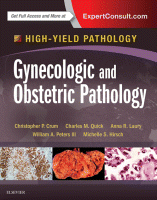Physical Address
304 North Cardinal St.
Dorchester Center, MA 02124

D efinition — Fetal infection by the single-stranded DNA parvovirus B-19. Clinical Features Epidemiology Parvovirus infection is a common occurrence in adult life. Congenital parvovirus occurs when a woman who has not been exposed to parvovirus contracts the infection for…

D efinition — A localized form of abruption due to acute spiral arterial bleed into the basal parenchyma associated with maternal hypertension. Clinical Features Epidemiology Most commonly associated with maternal hypertension and preeclampsia. You’re Reading a Preview Become a Clinical…

D efinition — Early separation of the placental disk from the underlying maternal surface. Clinical Features Epidemiology Placental abruption is a relatively common event, with an overall incidence of 1%. Numerous predisposing factors are thought to lead to abruption but…

D efinition — Metabolic deficits within the fetus that lead to the accumulation of a metabolite, typically visible in the placental villi. Clinical Features Epidemiology Lysosomal storage disorders and their placental presentations are rare events. The vast majority of cases…

D efinition — Infection resulting from the spirochete Treponema pallidum . Clinical Features Epidemiology The frequency of congenital syphilis in developed countries is much lower; however, a recent rise in the incidence has been noted. It is rarely encountered in…

D efinition — Infiltration of the intervillous space by a monomorphic population of histiocytes. Clinical Features Epidemiology Uncommon. Histiocytic intervillositis is associated with spontaneous abortion and recurrent pregnancy loss. Rare cases of maternal malaria or recurrent sepsis have been documented.…

D efinition — Maternal chronic inflammatory cells within terminal villi, not attributable to any known infection. Clinical Features Epidemiology Present in 5% to 10% of examined placentas. More often seen in women with autoimmune disorders such as systemic lupus erythematosus.…

PITFALL D efinition — Placental infection by the gram-positive bacteria Listeria monocytogenes . Clinical Features Epidemiology Placental infection with Listeria is an uncommon occurrence. The most common method of infection is ingestion of unpasteurized dairy products, although deli meats and…

D efinition — Infection by any species of Candida during the gestational period. Clinical Features Epidemiology Vaginal infection by Candida is common and is thought to occur in up to 25% of all pregnancies. Ascending infection of the placenta and/or…

D efinition — Ascending infection of the amniotic fluid leading to a fetal and maternal inflammatory response. Clinical Features Epidemiology Acute chorioamnionitis (ACA) is detected in approximately 25% of preterm deliveries, and gestational age of babies born with ACA is…